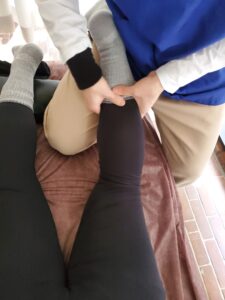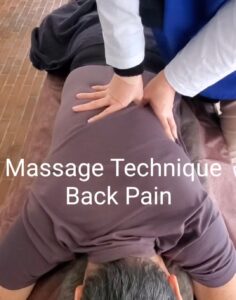首の痛み マッサージ
neckpain neckmassage
按摩・あんまとは、なでる、押す、揉む、叩くなどの手技を用いて健康を増進させる手技療法です。江戸時代から、按摩の施術を職業とする人を、按摩、あんまさんと呼びました。按摩の按とは「押さえる」という意味であり、摩とは「なでる」という意味になります。按摩は西洋発祥のマッサージとともに手技療法の一種ですが、按摩は衣服の上から遠心性(心臓に近い方から遠い方に施術を行うのに対し、マッサージは求心性指先から心臓に近い方に原則として肌に対して直接施術を行います。古代の人々の生活において、いろんな理由で負傷して疼痛、腫痛に苦しむこともあり、そんなときに、人々は、自分あるいは仲間の患部を、手で撫でたり擦ったりすることによって、外傷による疼痛を散らして腫れをひかせて痛みを和らげる効果があることを発見しました。これが按摩術のルーツであると考えられています。今回は、首の痛みに対して、横手を使っています。横手は開いた手の小指側の縁を体表に当てて手根を素早く前後に動かし筋肉の走行に滑らすように動かす手技です。この時、関節がコツコツと鳴るようにするために鳴骨の術とも呼ばれています。首のトリガーポイントに沿って手が移動する心地よい手技です。
Anma is a manual therapy that promotes health by using manual techniques such as stroking, pushing, rubbing, and tapping. Since the Edo period (1603-1868), people who practiced masseurship were called "Anma" or "Anma-san. The word "anma" in the word "masseuse" means "to press" and "ma" means "to stroke. Anma is a type of manual therapy along with massage, which originated in the West. Anma is performed centrifugally (from near to far to the heart) over clothing, whereas massage is performed directly on the skin as a rule from the centripetal fingertips to near the heart. In the lives of ancient peoples, people were sometimes injured for various reasons and suffered from pain and swelling. At such times, people found that stroking or rubbing their hands on the affected area of themselves or their companions was effective in dissipating pain caused by trauma, reducing swelling, and relieving pain. This is believed to be the root of the plyometric technique. In this case, the yokote is used for neck pain. Yokote is a technique in which the little finger-side edge of the open hand is placed on the body surface and the carpal root is moved back and forth quickly to slide it into the running of the muscle. At this time, it is also called nari-no-kone-no-jutsu because the joints are made to make a steady thumping sound. It is a comfortable technique in which the hand moves along the trigger points in the neck.


